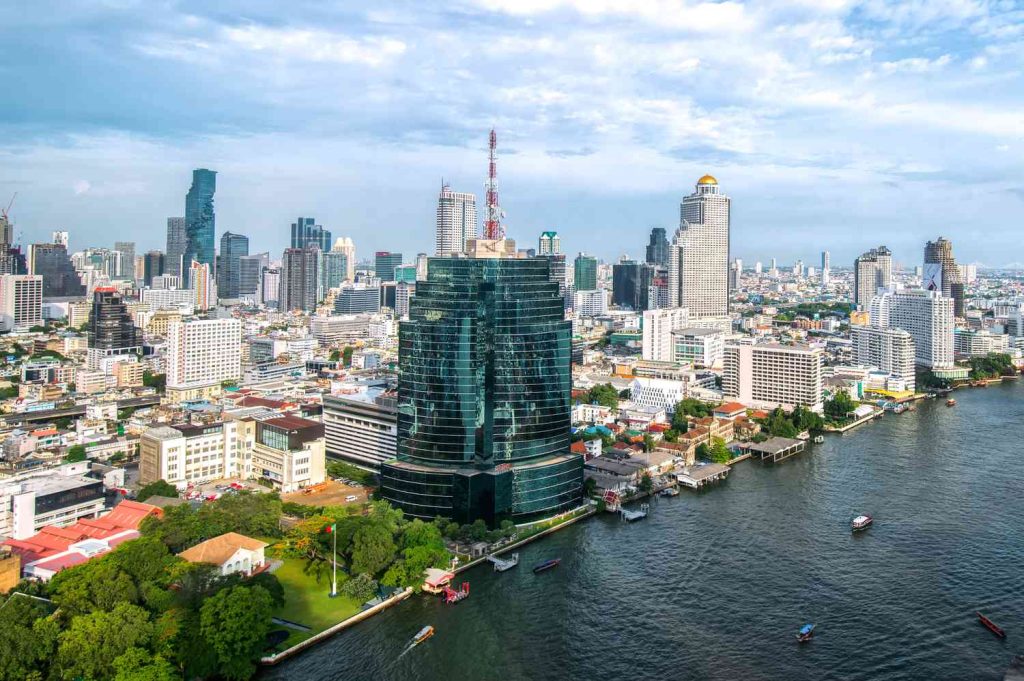:max_bytes(150000):strip_icc():format(jpeg)/TAL-header-skyline-bangkok-thailand-BNGKOKERTHQAKE0325-411c9aca6f5c4274911a0fe90fee333e.jpg)
On Friday, a 7.7 magnitude earthquake struck near Mandalay, the second-largest city in Myanmar, causing a ripple through the nation and into Thailand. Several powerful aftershocks quickly followed.
According to the New York Times, as of 9 a.m. Eastern, at least 20 people have been confirmed dead, and dozens more remain buried under high-rise buildings. However, the Associated Press noted that the death and injury toll is likely much higher, noting that very little information has been flowing out of Myanmar, which is currently in the midst of a civil war.
In neighboring Thailand, it appears as though Bangkok may be hardest hit, with the AP reporting that a 33-story building at the popular Chatuchak market has collapsed. An official told reporters, including at The Times, that 70 people were still missing and 20 people were trapped in an elevator shaft, though it was unknown if they survived.
According to the AP, the region is well-known for experiencing earthquakes. In fact, Bill McGuire, Professor Emeritus of Geophysical & Climate Hazards, University College London, shared on Science Media Center that “Myanmar is one of the most seismically active countries in the world, so this quake is not a surprise. It looks to have occurred on the major Sagaing Fault, which marks the boundary between two tectonic plates, and which runs north—south close to a number of large population centers.”
McGuire added that this is “probably the biggest earthquake on the Myanmar mainland in three quarters of a century, and a combination of size and very shallow depth will maximise the chances of damage. It is highly likely that build quality will generally not be high enough to survive this level of shaking, and casualty numbers will almost certainly climb significantly as more becomes known of the scale of the disaster.”
Still, Thailand’s Prime Minister Paetongtarn Shinawatra shared at a press conference that “Buildings in Bangkok are constructed beyond the (required) standard. Even if the earthquake had been stronger, they would still be able to withstand it. Right now, inspections show that all buildings are safe to return to. The only affected structures are those under construction, which have issues with stability and walls.”
Shinawatra added that there continue to be aftershocks, which may continue to “affect people in both northern Thailand and Bangkok.”
Anusak Laowilas/Getty Images
For its part, Malaysia’s Prime Minister Anwar Ibrahim shared in a statement, “I am deeply concerned by the powerful earthquake that struck central Myanmar and northern Thailand.” He added, “Malaysia stands in unwavering solidarity with our neighbours and fellow ASEAN Member States … Malaysia is ready to extend assistance and support humanitarian efforts as needed. In this time of shared grief and resilience, may recovery be swift, and may the strength of our regional bonds bring hope and healing.”
If you have travel plans to Thailand, they should not be affected. According to The Independent, Airports of Thailand (AOT) stated on Friday, “AOT has completed inspections of 6 airports, confirming that the structural integrity of their buildings and aviation infrastructure meets safety standards. All airports have resumed normal operations as of 2:30 p.m.”
However, travelers should be cautious of travel through affected areas and know that Bangkok has officially been declared a disaster area, which will most certainly affect any plans. The Bangkok Post also reported that the Ministry of Transport ordered the suspension of public transport services, including many buses and all its electric train lines. The ministry did, however, increase passenger boats, including the Chao Phraya River, to serve commuters. The State Railway is also experiencing delayed trains, pending safety checks on all tracks.
No word on if the U.S. will offer assistance. However, The Guardian noted that due to cuts and funding freezes by the Trump administration, the renowned Disaster Assistance Response Teams—teams of highly trained individuals who specialize in rapid response to disasters like this—can “no longer deploy.”
Those traveling to Thailand in the coming days are urged to stay tuned to official channels, including the Thai government’s page on X.
This story is ongoing. Updates will be made as information becomes available.








